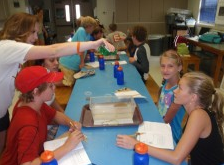
Candace Peyton, project manager of DROPPS, assists middle school students with experiments to test effectiveness of dispersing as an oil cleanup method. (Photo by: J. Findley)
The methods used to remove the oil from the Gulf of Mexico – skimming, soaking, and dispersing – were as much in the news as the Deepwater Horizon incident itself. Three years later, a group of twenty-six middle school students conducted experiments to compare these methods as part of a week-long University of Texas Summer Science Field Program. The Marine Science Institute (UTMSI) in Port Aransas hosted the field program, focusing on the Gulf’s marine ecosystem.
UTMSI post-doctorate Rodrigo Almeda and graduate student Tracy Harvey led the oil-spill activities at the science field program. They are members of Dr. Edward Buskey’s laboratory team for the research consortium Dispersion Research on Oil: Physics and Plankton Studies (DROPPS). The DROPPS consortium is studying how oil breaks down into droplets, travels under various conditions, and interacts with the plankton in the marine environment.
